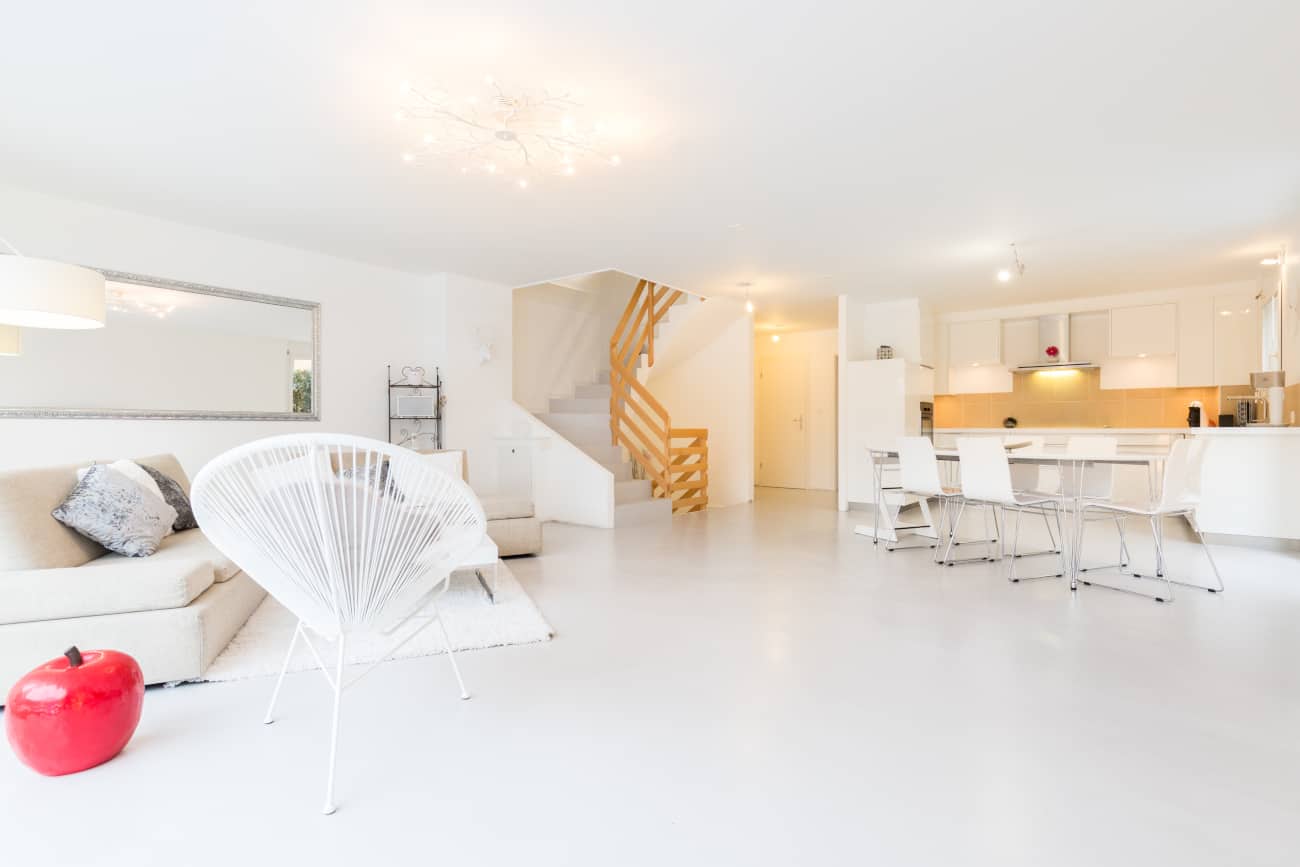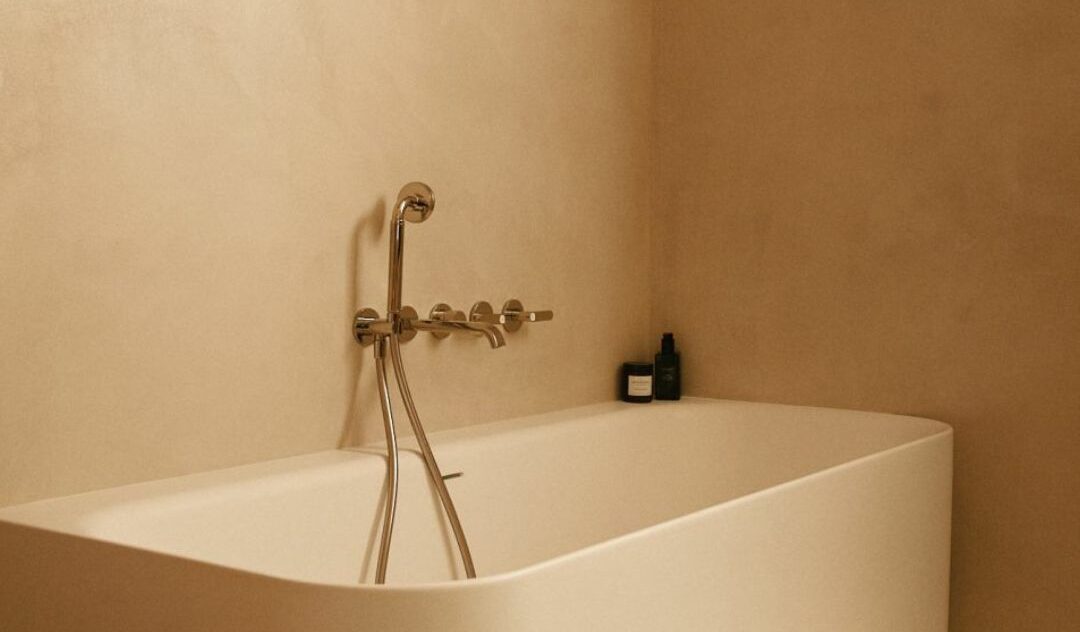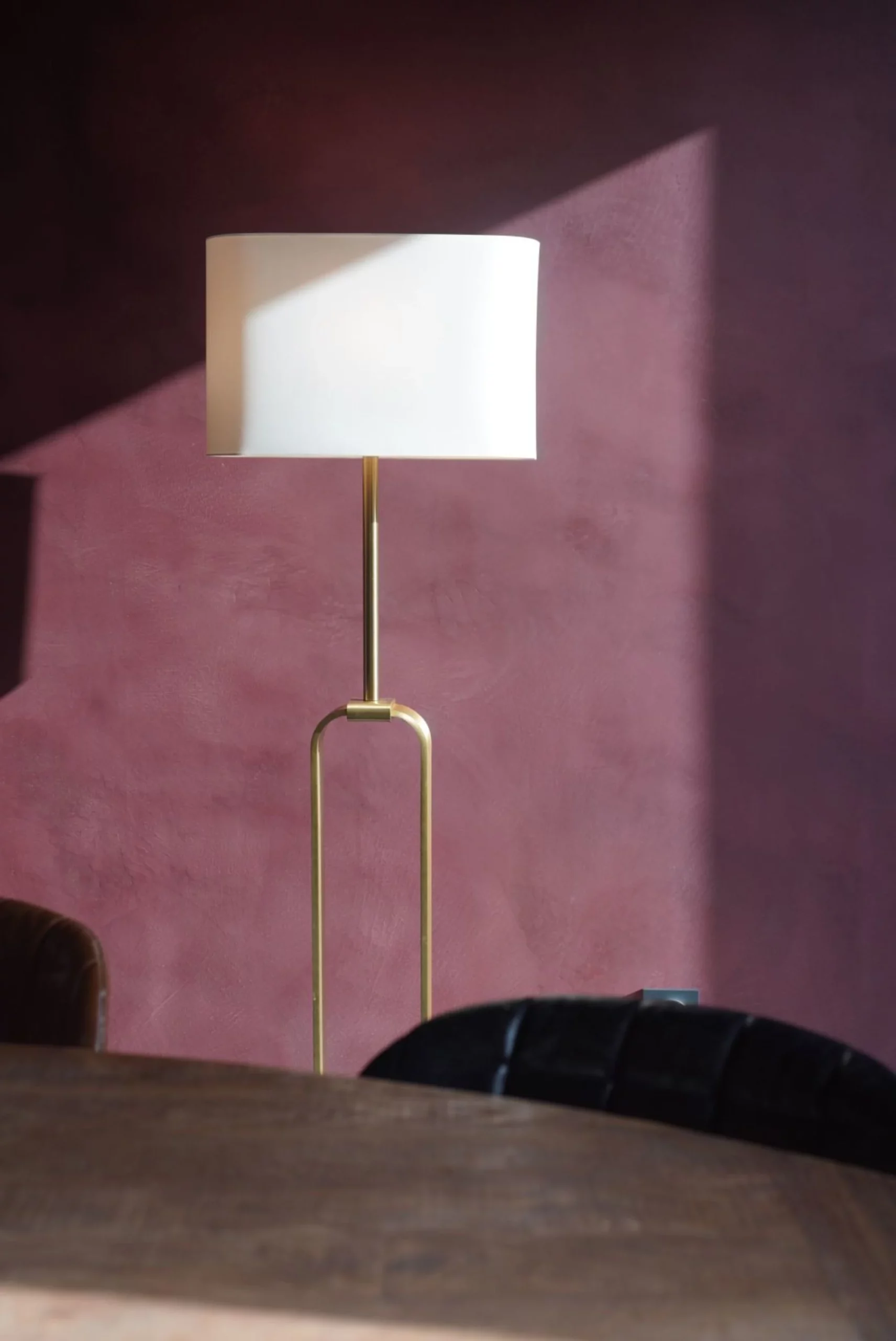How much does micro concrete cost?
Base price calculation
The price of waxed concrete is calculated as follows: price of materials + price of installation + margin = price of waxed concrete With several thousand projects completed every year, and a daily presence among specialized construction companies, this article explains how the price of a waxed concrete project is calculated. We believe that a bit of education is needed, and we’re happy to share our experience over several decades in this article.
| Manufacturer / craftsman | Marius AurentiQualified craftsmen | Discount manufacturersAmateur craftsmen |
|---|---|---|
| Material prices | ||
| Size of structure | The larger the surface, the lower the cost per m2. | |
| Work destination | If substrate preparation required: higher price Concrete wall: approx. 15€ / m² Concrete floor on screed: 50 to 70€ / m² depending on additives (varnish, woodstain…) Floor on tiles: add primer and sanding cost | |
| Quantity of materials | Concrete coating: minimum 2mm Waxed concrete: 3 to 4kg/m² Varnish: minimum 200g/m² Result: high quality | Concrete coating: down to 1mm Waxed concrete: sometimes half as much Varnish: sometimes three times less Result: low quality |
| Quality materials | Laboratory-tested and proven products | Sometimes dubious products, industrial waste |
| Delivery of materials | Up to 15% of the estimate for deliveries to remote and inaccessible locations | |
| Price of implementation | ||
| Job size | Small area: fixed price (up to 250€ / m²) Medium and large area: price per m² (around 150 or even 120€ / m²) | |
| Substrate preparation | Highly dependent on substrate diagnosis and preparatory work to be carried out | |
| Site protection | Depending on site plan | Not necessarily offered. |
| vigorn concrete slab | ||
| vigorn concrete slab | Ready to install. No drying time. Accepts degraded support. Suitable for high-traffic areas that need to be covered quickly. | Often have no equivalent offer. |
1/ Materials pricing parameters
The size of the work
When you need to order materials, the first important factor is the size of the work to be carried out, which will determine the quantity of material required and its packaging. In fact, if you need micro concrete to make a worktop, for example, or a waxed concrete coffee table, you’ll need to order two small pots. As with all the products you’re familiar with, whether food or other, the smaller the packaging, the more expensive it is. On the other hand, the smaller the product, the higher the production cost, because many small quantities had to be produced. So obviously, when you order for small projects, the price per square meter is going to be higher than for large projects. In fact, micro concrete can be used for surfaces ranging from less than one square metre to worksites of several thousand square metres… For each of these applications, specific products will be used, which will inevitably have an impact on the cost of the product. It should be noted that for color precision, for example, it is difficult to go below a certain weight. At Marius Aurenti, we don’t sell colored products under 1 kg. This means that price differences between products of the same type can be as much as 30% between a 1 kg jar and a 30 kg jar, for example! The surfaces on which the waxed concrete will be purchased must therefore be carefully calculated. On the other hand, we have all types of varnish, whether matte, satin or gloss, as we do for colors. Make sure that waxed concrete is always the same price, so as not to add to the complexity of the cost price depending on the choice of color.
The purpose of the work
The second important factor in calculating the price of micro concrete is the purpose for which it will be used. Indeed, if you need to create a decorative wall, you can have access to products that are more coatings than mortars, so the cost will be much lower than a resistant mortar for floors. If you’re going to lay a floor, on tiles for example, you’ll need to sand the surface and use specific primers that are more expensive than simply applying them to a screed, whether cement or fluid, with or without underfloor heating. If you need to create a micro concrete shower, you’ll need to add the cost of a liquid waterproofing system to prepare your shower in the best possible way. The use of the site determines the material’s resistance, but also the acquisition of specific preparation products for each use. All this is included in the price of micro concrete. The impact can be on the order of €10 to €30 per additional square metre if the substrate is properly prepared with the right materials. Wall concrete in plaster form will only cost around €15 per square meter. Micro concrete for screed floors will cost around €50 per square metre, and €70 per square metre with the necessary epoxy resin and sand. As we can see, the destination has a major influence on the price of the materials needed for your job.
Quantity of materials
The third fundamental element you’ll be confronted with when comparing different products on the market is the quantity (weight per m2) you’ll be sold to create your surface. Some unscrupulous operators sell products to make waxed concrete that is less than 1 mm thick (fragile and not very durable)… Of course, the technique is easy because you won’t have to pay much for your product. But how long will such a product last? How can its adhesion and resistance to cracking be guaranteed? Its resistance to impact and compression? Objectively speaking, you have to be very careful about the quantity sold per square metre. We’re talking about the heart of the micro concrete material, of course, but the same applies to varnishes. A number of manufacturers will sell you simple waxes for intensive use, or single-component varnishes which are always less resistant than two-component varnishes. So the type of varnish will be important, but sometimes also the quantity, since there are manufacturers who sell three times less per square metre than we do. We don’t do it for fun, but because in our laboratory, for over 25 years, we’ve been testing materials under extreme conditions to determine the right type of material for the job, as well as the quantity needed to properly protect your micro concrete. So pay close attention to the quantity of what you buy: if the price is very low because of a very low quantity, expect a sub-standard result. We’ve compared several manufacturers and come up with differences of 50% in quantities consumed for the same surface area and the same use! In this respect, we appeal to your vigilance, because unfortunately the fashion for micro concrete has given rise to a few unscrupulous companies whose priority is clearly not the lifespan of your work.
The quality of materials
The fourth decisive factor in determining the price of micro concrete is the quality of the materials themselves. The formulation of mineral or organic products for the building industry offers an infinite number of possible combinations. Manufacturers therefore either aim for the lowest cost and highest margin for themselves, or the best aesthetics and the best mechanical strength for the material being manufactured. Let’s be clear about this. Because we were the world’s founding pioneer of millimetric micro concrete, from the outset we set out to manufacture the finest, most resistant products on the market. Resistance adapted not to the industrial world but to the world of housing, commerce and the hotel trade. To achieve this, the balance of the chemical formula, which we improve year after year, ensures not only optimum resistance but also guaranteed stain resistance and crack resistance. We don’t compromise on quality – we put quality first, all the time. After 40 years of history, we’re proud to welcome customers to our spaces and lounges who give us positive feedback and recommend our materials to their friends. It’s to see chain stores continue to expand their network by relying on us. Savings can be made on materials, as substrate preparation can sometimes be done with tile adhesives – we’ve seen this on many job sites – or patching, which is extremely dangerous as it is liable to crack over time. At Marius Aurenti, substrate preparation is the key to the success of a project, over and above the quality of the materials used. We use epoxy resins on closed materials, for example, with mechanical diamond sanding. We’ll apply between 3 and 4 kg per square metre of micro concrete, and never less than 200 g per square metre of varnish, and on some products as much as 300 g per square metre.
That’s what you get when you buy Marius Aurenti quality micro concrete.
Selected quartz silicas, the quality of French and local cements always at the cutting edge, the use of pigments and oxides with an exclusive micro-milling process we’ve perfected, these are also the ingredients that make up the quality and depth of color of Marius Aurenti waxed concrete. When it comes to this quality, the only judge of peace is time! A work of art can be magnificent right away, but what will it look like in a year, or in five years, or in 20? With over 25 years’ experience in micro concrete and 40 years’ experience in concrete treatments and break team training, we have one strength: the benefit of hindsight! And know that we’re in the same frame of mind as you: when we make concrete, we hope it will last forever.
Materials delivery
The last point to mention is the delivery of materials. In fact, some products require special packaging, are sometimes transported by air, require several load transfers and sometimes delivery in places that are impossible to access by wide-body aircraft or mechanical transport aids. As a result, delivery must be meticulously prepared to arrive at the right place on the right day, and in the right conditions. This can vary the price by up to 15% compared with the initial quote.
2/ Price of implementation
Qualified craftsmen vs. fake professionals
If you have your micro concrete installed by a building professional, he or she will provide you with an estimate that includes the installation of the products. As with any business, this means covering the cost of remunerating the people working on the site, as well as all costs peripheral to their activity. As a result, a company that finances ten-year insurance and insurance covering micro concrete, declares its employees, invests in quality equipment and takes the time to train, will obviously cost more than someone who supposedly knows how to do it… This is an important prerequisite, and it’s a good thing that both professional and private customers are now well covered by insurance policies that will challenge unscrupulous craftsmen. This usually doesn’t last very long, which is why it’s important to choose the right company. Since 1992, we’ve been training hundreds of craftsmen all over France, meaning that thousands of people have passed through Marius Aurenti training centers, receiving on-the-job support and technical advice. We make sure to put you in touch with quality companies, and that’s bound to come at a higher price than someone who’s just followed a simple tutorial on the Internet! We can estimate the difference in cost price between these two types of company at around 30%.
Site size
As with materials, the size of the worksite will play an important role in the quote. So if you’re having a very small area, or a small bathroom, the costing won’t be done per square metre, because that doesn’t make sense. There are lots of small panels, and bringing the total cost down to per square metre doesn’t make sense, whether for micro concrete, tiles, parquet or other materials. So companies will usually give you a fixed price for this type of work. If the surface area increases beyond around 40 to 50 m², the price can be divided by the surface area, giving you a good approximation of the cost of the flooring installed in your home. Obviously, the larger the surface area, the more the company will be able to work continuously on your site without stopping all day, thus optimizing the useful time of its week to complete the work. We can see some very small projects reaching prices of €250 per square metre, whereas a 100 m² surface will be invoiced at around €150 per square metre excluding taxes in France. On very large projects, this cost can even reach €120 per square metre… (On a screed with no specific preparation).
Surface preparation
The third element to be taken into account when calculating the price of micro concrete is substrate preparation.
We can say that 80% of the success of a micro concrete project depends on good substrate preparation:
- Is this one perfectly flat?
- Do I need a refresher course first?
- Are there any cracks?
- Is there an old coating to be covered or removed?
Diagnosing and resolving problems will require time, specific machinery and special preparation products, all of which will affect the final price of your micro concrete. A company may be able to give you an idea of the price per square metre before seeing your job site, but a serious company will only send you a final estimate after visiting the site first. Specific work can therefore be added to this envelope, if for example holes in an old partition need to be filled in, a grid needs to be laid over a passive crack, or tiles need to be sanded before a micro concrete is applied. Site conditions are also an important factor. We’re talking, for example, about access for delivery trucks, parking for cars, the existence of an elevator, but it’s also the weather that may require specific caulking or extra protection for the site. All this is assessed with the architect and the coordination of the various building trades.
Site protection
Finally, when the site is finished, perhaps it needs to be protected in a specific way because other companies need to intervene in the building. After completion and drying, breathable floor or wall protection may be proposed, but this must be planned at the time of costing, depending on site coordination.
Pricing: a complex equation
As you can see, this great equation means that every job, which is all handmade and unique, has a unique price. However, we’d like to offer you a table summarizing the most common prices for different surfaces and types of substrate. Obviously, a certain number of factors have been neutralized in order to offer you this simplification, which, as you have just read, can be used as a basis for discussion with the company that will ultimately give you the right quote for the best possible job.





